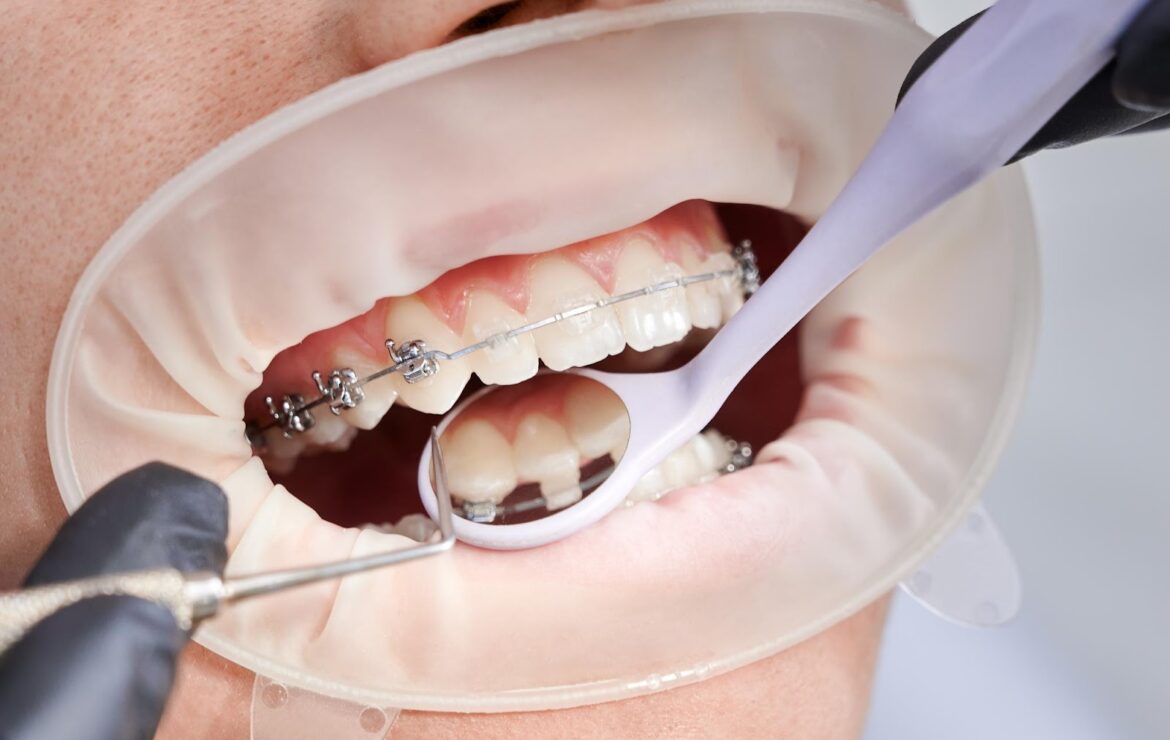Metal Braces vs. Ceramic Braces

Metal Braces vs. Ceramic Braces
Here’s a revised version of your blog with all the corrections, enhancements, and SEO keywords seamlessly incorporated:
How Are Metal & Ceramic Braces Different?
When it’s time to get braces, you have options. Two of the most popular choices are traditional metal braces and ceramic braces. But what sets them apart? This guide will help you understand the differences between these orthodontic options, their benefits, and how to choose the right one for your smile.
What Are Metal Braces and How Do They Work?
Metal braces are the most common type of orthodontic braces. They consist of stainless steel brackets bonded to the teeth, connected by wires, and held together by elastic bands known as ligatures. The wires exert constant pressure to gradually move the teeth into better alignment.
In some cases, self-ligating braces are used, which feature built-in clips instead of elastic bands to hold the wire in place. Metal braces are known for their durability and effectiveness, making them a popular choice for patients with moderate to severe misalignment.
What Are Ceramic Braces and How Are They Different?
Ceramic braces function similarly to metal braces but have a key difference: the brackets are made from clear or tooth-colored ceramic material, making them less noticeable. They can also include frosted or white-colored wires to blend seamlessly with your teeth.
Like metal braces, ceramic braces are available in traditional and self-ligating versions. While ceramic braces are often chosen for their aesthetic appeal, they are slightly more fragile than metal braces and require extra care.
Clear Braces: Are They the Same as Ceramic Braces?
Although clear braces is a term often used to describe ceramic braces, it can also refer to clear aligners like Invisalign. Clear aligners are removable prescription trays that fit over your teeth to straighten them gradually. They are ideal for patients with mild alignment issues who want an alternative to fixed braces. If you’re considering clear braces, consult a dentist or orthodontist to determine the best option for your needs.
Materials: Metal vs. Ceramic Braces
The primary difference between metal and ceramic braces lies in the material of the brackets:
- Metal Braces: Made from medical-grade stainless steel, which is strong, durable, and noticeable.
- Ceramic Braces: Made from polycrystalline alumina, which is tooth-colored or transparent, offering a more discreet look.
The wires connecting the brackets can also be customized. Ceramic braces often use white or frosted wires to enhance their aesthetic appeal.
Pros and Cons of Metal and Ceramic Braces
Benefits of Ceramic Braces
- Less visible due to tooth-colored or clear brackets.
- Provides the same reliable technology as metal braces.
- A more confident smile without the “metal mouth” appearance.
- A smoother feel, which may reduce discomfort compared to metal brackets.
Drawbacks of Ceramic Braces
- More fragile and prone to breakage compared to metal braces.
- Costlier due to the high-quality materials used.
- More prone to staining from foods and beverages like coffee, tea, or red wine.
- Can potentially damage the enamel of opposing teeth if bonded to lower teeth.
Benefits of Metal Braces
- Strong and durable, ideal for treating complex orthodontic cases.
- More affordable than ceramic braces.
- Effective for severe misalignments and bite issues.
- Not prone to staining like ceramic brackets.
Drawbacks of Metal Braces
- Highly visible, which may affect confidence for some patients.
- Can cause discomfort or irritation to the lips and gums.
- Requires periodic tightening, which may result in temporary soreness.
- Difficulty eating sticky or hard foods during treatment.
Cost Comparison: Metal vs. Ceramic Braces
The cost of ceramic braces are typically higher due to increase in cost of the braces kit and adjunctive materials. Metal braces are more affordable in comparison. The overall cost of the treatment depends on the complexity of treatment, treatment duration and the dental clinic. Factors influencing the cost include:
- Additional Appliances: Some patients may require attachments like rubber bands or expanders, which can increase costs.
- Clinic Charges: If the treatment is performed by an orthodontist in Mumbai working at a reputed dental clinic in Mumbai, clinic fees may also affect pricing.
- Treatment Duration: Longer treatment times generally lead to higher costs.
Which One Is Right for You?
Choosing between metal and ceramic braces depends on your specific needs, budget, and preferences:
- If durability and affordability are priorities, metal braces are the better choice.
- If aesthetics and a discreet appearance are important, ceramic braces may be ideal.
- For those seeking a removable and invisible option, clear aligners like Invisalign aligners could be a great alternative.
An experienced orthodontist at an orthodontic dental clinic can help you make the right decision based on your case.
Conclusion
Both metal and ceramic braces offer effective solutions for straightening teeth and achieving a healthy smile. While metal braces are durable and cost-effective, ceramic braces are more discreet and appealing aesthetically. If you’re considering braces or clear aligners, consult the best dentist in Mumbai to explore your options and get a personalized treatment plan.
Ready to transform your smile? Book a consultation at a trusted dental clinic in Mumbai today to get started on your orthodontic journey!








